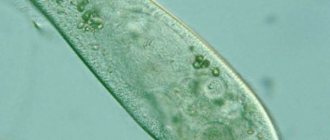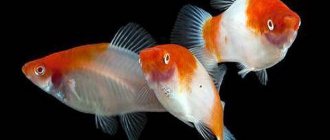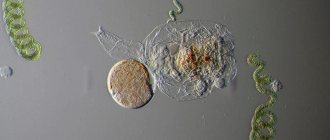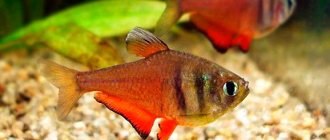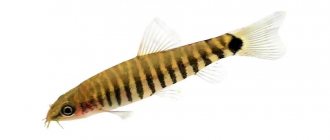Author: Tapir Kaisa
13 August 2021 11:34
Tags: ciliates food for fry breeding
14280
5
First you need to acquire some equipment. You will need several three-liter jars, a regular medical syringe with a glass pipette tip instead of a plastic tip, a warm room ~26*C, with soft, indirect sunlight. A small piece of glass and a lens (shoe size from 0.1-0.3 mm).
Shoe culture.
0
If everything is quite simple with the technical part of the process, then everything else will have to be dealt with literally point by point. Firstly, where can I get the slipper culture? There are several options. The easiest one is to ask your older comrades for it. The advantages are simply huge. Firstly, you know that you were given a pure culture without various crustaceans that can not only benefit, but also kill the shoe culture, i.e. you receive obviously clean material to work with. Or go to a pond and scoop up water at the very bottom (preferably with some silt). If you chose the second option, here you will need a piece of sheet glass (5*10 cm), a magnifying glass or a microscope, a pipette or syringe, and a sharpened match. First, take a drop of water and place it under a microscope, in it you will see a cluster of various protozoa, and you can also easily distinguish the shoes.
×
Study Opportunities
You can hear the story about the slipper ciliate in school, but not everyone knows how exactly the researchers studied the tiny organism. In fact, there is nothing difficult in observing it, in addition, a size of tenths of a millimeter is quite large for protozoa. All this means that research can be carried out even at home, but first you need to breed a culture of ciliates.
Since slippers are present in all bodies of water, water is taken from these sources. For the purity of the experiment, you need to take three glass containers and put decomposing twigs and leaves in one of them, living plants in the other, and sludge from the bottom in the third. All materials are taken from the reservoir, and liquid is also extracted from there and poured into jars. When everything is ready, you need to carefully examine the contents of the container and make sure that there are no foreign organisms visible to the eye, such as insects or larvae. If they are present, they will have to be caught, otherwise the ciliates will be eaten. The prepared habitat is placed on a window, covered with glass and left at room temperature for several days. In this case, you need to ensure that the container is not exposed to direct sunlight. After two days, the jar should be shaken and checked to see if any organisms have appeared there. These could be shoes or other creatures, but this is easy to check. You need to take a drop of water from the illuminated wall of the vessel closer to the surface; it is in this place that most of the organisms of interest will concentrate. Then the drop should be placed on glass and examined through a microscope or at least a magnifying glass.
If at the same time fusiform bodies are visible, moving quickly and smoothly and rotating around their axis, it means that the shoes have been separated. If there is a piece of greenery or a bacterial film in the drop, many ciliates will immediately accumulate around the food.
To speed up the reproduction process of ciliates, you need to place them in a favorable environment
It is not difficult to separate the slippers from other animals. They usually move much faster than other organisms, and this is what you need to take advantage of. To do this, a drop, which contains several types of creatures, is placed on glass and placed in a well-lit place. A small amount of fresh water is poured next to it and a toothpick is used to draw a line from one liquid to another so that a thin water bridge is formed connecting the two media. The ciliates will quickly cover the distance and end up in a new drop.
It happens that you cannot see anything living in the water, in which case you can add a few drops of boiled milk to the container and wait another two days. After this time, you can once again try to study the developed organisms.
Next, the shoes will multiply; this process can be accelerated by creating favorable conditions for them. To do this, they are placed in one of the following environments:
- on dried banana peel;
- on lettuce leaves;
- into milk;
- in an infusion of hay.
Organisms bred in this way can be used to observe them for research purposes or bring practical benefits. Since ciliates are natural cleansers of fresh water, they can disinfect liquid in fish aquariums and also serve as food for fry.
Thus, slipper ciliates are amazing organisms with unique characteristics (for example, sexual process without reproduction), they can be studied even at home.
BARTEMIA: DESCRIPTION, BREEDING, VIDEO, STORAGE AT HOME
GAMMARUS FOOD FOR AQUARIUM FISH.
Rotifers DESCRIPTION BREEDING PHOTO VIDEO.
The shoes are quite mobile.
0
Take a drop of clean water (with a pipette) and place it next to a drop from a pond. If there are a lot of protozoa, try to select the part where only ciliates are present (you only need a few full-fledged individuals), so if you are not able to separate them with a pipette, then use the tip of a toothpick to connect 2 drops of water with a small channel, unlike other protozoa, ciliates will quickly swim across it, into fresher water. By repeating this several times, you can obtain a fairly pure culture of ciliates.
Advantages and disadvantages of “live dust”
Breeders prefer ciliates to the abundance of feed on the modern market for a number of reasons:
- It does not pollute the aquarium. Any organisms not eaten will simply remain there without disturbing the system.
- Contains a lot of nutritious protein, which helps the fry grow faster.
- Due to its size it is suitable for the smallest inhabitants of the aquarium.
- Breeding single-celled animals does not require large financial investments.
- Any child can grow a colony of ciliates.
- The risk of infection getting into the aquarium is almost zero.
There are few disadvantages to this food. Among them:
- unpleasant odor of organic waste used for cultivation;
- cultivation takes 7 to 10 days;
- It is difficult to move food without the rotten water in which it grows into the aquarium.
Despite the difficulties that may arise during cultivation, experts advise using single-celled animals instead of dry food. Because You need to feed the fry 6-8 times a day, it is difficult to calculate the dosage of food, and the abundance of food will harm other fish and greenery in the aquarium, and pollute the water.
With shoes everything is much simpler; they will not die, but will be eaten by other fish.
Incubator
0
After this, it is necessary to place the culture in an incubator. Half a jar of clean water is enough; the jar is placed in a warm, illuminated place, but not in direct sunlight. As a nutrient, 1-3 drops of milk are dripped into the jar. And a culture of ciliates is placed, which begin to multiply quite quickly. Ciliates feed on bacteria that serve as food for them, so they often accumulate around pieces of organic matter, or near the surface if a bacterial film occurs or if there is not enough oxygen.
Life processes
Nutrition
The slipper and some other free-living ciliates feed on bacteria and algae.
Reaction of ciliates to food
The thin elastic membrane (cell membrane) covering the ciliate from the outside maintains a constant body shape. There are about 15 thousand cilia on the surface of the body. There is a depression on the body - a cellular mouth, which passes into a cellular pharynx. At the bottom of the pharynx, food enters the digestive vacuole. In the digestive vacuole, food is digested within an hour, first with an acidic and then with an alkaline reaction. Digestive vacuoles move in the body of the ciliate by a current of cytoplasm. Undigested remains are thrown out at the posterior end of the body through a special structure - a powder located behind the mouth opening.
Breath
Breathing occurs through the covers of the body. Oxygen enters the cytoplasm through the entire surface of the body and oxidizes complex organic substances, as a result of which they turn into water, carbon dioxide and some other compounds. This releases energy that is necessary for the life of the animal. Carbon dioxide is removed through the entire surface of the body during respiration.
Selection
In the body of the slipper ciliate there are two contractile vacuoles, which are located at the anterior and posterior ends of the body. They collect water with dissolved substances formed during the oxidation of complex organic substances. Having reached their maximum size, contractile vacuoles approach the surface of the body, and their contents pour out. In freshwater unicellular animals, excess water that constantly enters their body from the environment is removed through contractile vacuoles.
Irritability
Slipper ciliates gather towards clusters of bacteria in response to the action of the substances they secrete, but swim away from such an irritant as table salt.
Irritability is the property of all living organisms to respond to stimuli - light, heat, moisture, chemicals, mechanical influences. Thanks to irritability, single-celled animals avoid unfavorable conditions and find food and individuals of their own year.
BREEDING AT HOME
There are many ways to breed slippers, on banana peels, hay, milk, dried lettuce and baker's yeast, etc. For myself, I chose the simplest, banana peel, or milk. I always had some of these products on hand.
I'll explain the difference. In milk, the slipper culture multiplies and develops more quickly, but also disappears quite quickly. On a banana peel (which needs just a little S = 1-3 cm2), the culture lives longer, but it also takes longer to grow, but there is a huge plus, there may not be milk in the house, and the peel of a ripe banana needs to be dried and can be used quite for a long time.
Any living creature, even a single-celled one, needs food. The slipper ciliate is no exception. The nutrient medium for it is microorganisms. This means that it is necessary to prepare an environment where they will be present in sufficient numbers. Take any container and pour aquarium water into it. Try to collect it closer to the surface where the plants come out. Almost every aquarium with a formed biological structure already has its own ciliates, even if there are only a few of them for now.
Both crops must be kept in the sun for at least a week (if longer, even better). The optimal time for growing ciliates is therefore summer. When the water turns dark, it is a sign that a bacterial colony has developed. Next, ciliates come into play . You can track their appearance even without microscopes and magnifying glasses: the water should turn pinkish.
Everything worked out? You can propagate a colony by taking another container with a similar bacterial culture and adding some water from the first one. The fry need to be fed literally with drops of water from the container where the ciliates live. If you add more food than the fry can eat, the shoes will simply die, and their decay products will poison the water. Of course, it is better to start with water from an open reservoir, where there are many more ciliates. And in any case, it is advisable to have a microscope to accurately assess the content of microorganisms.
HAY INFUSION CULTURE
As food for ciliates, you can use hay infusion, dried peels of banana, pumpkin, melon, yellow swede, carrots cut into circles, fish feed granules, milk, dried lettuce, pieces of liver, yeast, algae, i.e. those substances that are either directly consumed by shoes (yeast, algae) or are a substrate for the development of bacteria.
When using hay, take 10 g of it and place it in 1 liter of water, boil for 20 minutes, then filter and dilute with an equal amount or two-thirds of the settled water. During boiling, all microorganisms die, but bacterial spores remain. After 2 - 3 days, hay bacilli develop from the spores, serving as food for ciliates. As needed, the infusion is added to the culture. The infusion is stored in a cool place for a month .
The simplest way is to breed the shoes in skimmed, boiled or condensed (sugar-free) milk : it is added to the culture 1 - 2 drops per 1 liter) once a week. Shoes use lactic acid bacteria.
When using the above feeds, it is important not to overdose the food. Otherwise, rapidly multiplying bacteria will leave the ciliates without oxygen. When ciliates are grown on bacteria, they have positive phototaxis, i.e. strive for the light.
You can breed ciliates on scenedesmus and chlorella algae. Good results can be achieved when cultivating ciliates with weak blowing, when 1 granule of carp feed is added per 1 liter of algae. Ciliates fed with algae have negative phototaxis: they tend to the dark. This property can be used when feeding unloving fish larvae. Ciliate culture is used, as a rule, for no longer than 20 days. To continuously maintain the culture, it is charged in two jars at intervals of a week, with each jar being recharged every two weeks. For long-term storage of ciliate culture, it is placed in a refrigerator and stored at a temperature of + 3° - + 10°C.
Recently, quite by accident, I discovered another way to obtain a slipper culture. After siphoning the aquarium, I drained the water from the sediment and poured it into three plastic 2-liter bottles, put them on the balcony, in the sun (I needed “green” water, to feed the caught daphnia for a week). I used two for their intended purpose, but didn’t have time to use the third - the green stuff had settled. This always happens if you don’t add fresh water - microalgae “eat away” all the organic matter and microelements and die.
So, when the “green stuff” precipitated, the bottle contained just an awesome amount of ciliates, large, well-fed, everything just right. And, by the way, without any fertilizing, the culture lasted for more than a week - on the rotting remains of microalgae.
Description
The size of the shoes is tiny, but at the same time, relative to other single-celled organisms, they are quite large. An adult shoe can reach sizes of up to 0.3 mm, however, some managed to grow individuals up to 0.6 mm. The body is elongated, semicircular in cross section. The outer membrane serves as the outer shell of the body. It is transparent, so through it you can see the entire internal structure of the ciliates. The macronucleus is the most prominent among other organs. It appears as a fatty spot on the body. On the surface of the shoes there are cilia, with the help of which the ciliate moves and hunts. Their number can vary from 10 to 15 thousand.
Ciliates parasites
Along with harmless ciliates, there are also parasitic ciliates and they can harm the health of various invertebrate and vertebrate animals. In aquarium farming, significant harm is caused by ciliates that parasitize the body of fish. These pathogenic ciliates can cause a number of serious diseases, often accompanied by the death of fish.
Parasitic ciliates include: Ciliate ciliate (disease - Ichthyophthyriasis), Cryptocarion ciliate (disease - Cryptocarionosis), Ciliate ciliate Chilodonella spp. (disease - Chilodonellosis or milk disease), ciliate Brooklynella sp. (disease - Brooklynellosis), Trichodina sp. (disease - Trichodinosis), ciliate Tetrahymena sp. (disease - Tetrahymena), ciliate Carchesium. Epistylis sp. Vorticella sp. (disease - False mold).
A large number of different parasitic ciliates may be present in a home aquarium, but they primarily affect only fish with a weakened immune system.


